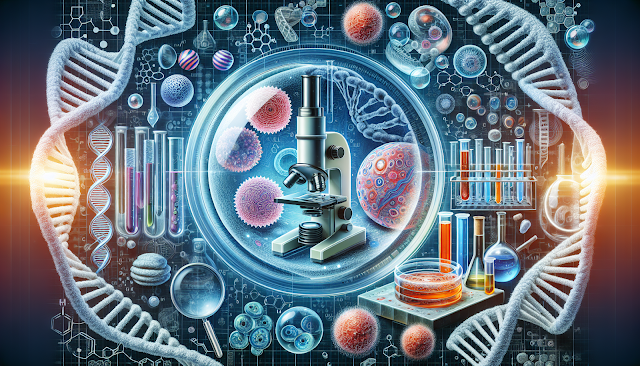What is the world of Biotechnology ?
Biotech Explained: A Deep Dive into the World of Biotechnology
Biotechnology, or biotech, stands at the confluence of biology and technology, harnessing living organisms and biological processes to forge technological innovations that span various sectors, including medicine, agriculture, and environmental conservation.
This field, rich with potential, leverages biodiversity to create a plethora of applications from antibiotics and vaccines to advancements in genomics and bioinformatics, demonstrating its pivotal role in shaping a sustainable and healthier future.
Mapping the evolution of biotech from ancient practices such as the use of rennet for cheese production to modern-day breakthroughs in genetic engineering and molecular biology, this article embarks on a comprehensive exploration of the domain.
It delves into the heart of biotechnology, highlighting key fields, innovative technologies, and its significant impact on healthcare, while also considering the ethical and environmental implications inherent to this dynamic field.
Historical Evolution of Biotechnology
Early Practices and the Dawn of Modern Biotechnology
Ancient Biotechnological Practices: Long before the term 'biotechnology' was coined, ancient civilizations were already harnessing biological processes.
The production of cheese using rennet and the domestication of animals are prime examples of early biotechnological practices. Similarly, the art of bread making and the use of fermentation for brewing beer and producing cheese were well-established by various cultures across the globe.
Zymotechnology to Industrial Biotechnology: The historical journey of biotechnology began with zymotechnology, which primarily focused on brewing techniques.
Over time, this field expanded to address broader industrial issues, eventually leading to the development of industrial fermentation processes.
This period marked the transition from traditional biotechnological practices to more complex applications in various sectors.
Foundational Advances in the 20th Century: The term 'biotechnology' was first introduced in 1919, around the same time significant advancements were being made, such as the production of the first experimental corn hybrid in 1870.
The discovery of DNA's 3D structure in the 1950s further propelled the field into the modern era, setting the stage for genetic engineering and molecular biology.
These discoveries were pivotal, as they laid the groundwork for future innovations in the field.
Key Developments in Modern Biotechnology
Genetic Engineering Breakthroughs: The development of recombinant DNA technology by Paul Berg and Stanley Cohen, along with the seminal discovery of DNA structure by James Watson and Francis Crick, marked significant milestones in biotechnology.
These breakthroughs have been fundamental in advancing genetic engineering and genomics.
The Human Genome Project: Initiated in the 1990s, this monumental project aimed to map the entire human genome. It successfully identified the structure of all three billion base pairs and approximately 22,000 genes, completing its mission in 2003.
This project not only enhanced our understanding of human biology but also laid the foundation for personalized medicine, transforming healthcare practices.
Biotechnology in the Pharmaceutical Industry: By the late 1990s, the biotechnology sector had seen rapid growth, evidenced by the approval of over 125 genetically engineered drugs by the United States Food and Drug Administration.
This era also witnessed the production of synthetic human insulin in 1978, proving the vast potential and applicability of biotechnological innovations in medical science.
Main Fields of Biotechnology
Biotechnology encompasses a diverse range of fields, each contributing uniquely to advancements in science, healthcare, agriculture, and industry.
This section highlights the main fields of biotechnology and their specific applications.
Agricultural and Environmental Biotechnology
- Agricultural Biotechnology: This field focuses on genetically enhancing plants to increase crop yields, improve resistance to pests and diseases, and reduce agricultural dependency on chemicals.
- Environmental Biotechnology: Techniques in this area are used for bioremediation, which involves cleaning up environmental contaminants through biological means, thus supporting biodiversity and ecosystem health.
Medical and Industrial Biotechnology
- Red Biotechnology: Pertains to medical applications such as the development of new drugs, vaccines, and genetic diagnostics. It also includes regenerative medicine like stem cell therapies and tissue engineering.
- White Biotechnology: Also known as industrial biotechnology, it utilizes enzymes and microorganisms to create biofuels and biodegradable plastics, contributing to sustainable manufacturing processes.
Advanced Biotechnological Applications
- Bioinformatics (Gold Biotechnology): Utilizes computational tools to manage and analyze biological data, playing a crucial role in genetic research and sequencing projects.
- Synthetic Biology: Involves redesigning organisms for specific purposes by engineering them to have new abilities, such as producing pharmaceuticals or biofuels more efficiently.
These fields illustrate the breadth of biotechnology's impact across different sectors, demonstrating its vital role in advancing modern science and technology.
Innovative Technologies in Biotechnological Research
CRISPR-Cas9 and Genome Editing
- CRISPR-Cas9 Technology: Revolutionizing genetic engineering, CRISPR-Cas9 allows for precise alterations to DNA, enhancing capabilities in gene therapy and agricultural biotech.
- Genome Sequencing Advances: The accessibility and affordability of genome sequencing have significantly increased, propelling personalized medicine and genetic research.
Biotechnological Applications in Medicine and Agriculture
- Monoclonal Antibodies (mAbs): These engineered proteins target diseases with high precision, becoming fundamental in treatments across various medical fields.
- Agricultural Enhancements: Genetic modifications in plants, such as increased environmental stress resistance, highlight biotech’s role in sustainable agriculture.
Emerging Technologies and Their Implications
- Artificial Intelligence in Biotech: AI and machine learning analyze complex biotech data sets, identifying patterns that accelerate innovation and improve predictive models in healthcare.
- Organ-on-a-Chip: Microfluidic devices that mimic human organ functions, crucial for drug testing and disease research, represent a significant leap in medical biotechnology.
Biotechnology in Healthcare
Biotechnology has significantly transformed the healthcare landscape, offering innovative solutions and enhancing patient outcomes. This section explores the pivotal contributions of biotechnology in healthcare, focusing on drug development, personalized medicine, and advanced diagnostic tools.
Biopharmaceuticals and Biomanufacturing
- Biopharmaceuticals: These are therapeutic products developed using biotechnological techniques, capable of treating a wide array of diseases by targeting their mechanisms more precisely than traditional pharmaceuticals.
- Biomanufacturing: A process that utilizes biological systems to produce biobased products, including essential drugs for the global bioeconomy, thereby revolutionizing the availability and efficacy of treatments.
Genetic Engineering and Personalized Medicine
- Genetic Engineering: This involves manipulating the genetic makeup of organisms to enhance or modify their properties, which in healthcare leads to breakthrough therapies and treatments.
- Personalized Medicine: Tailoring treatments to individual genetic profiles enhances treatment efficacy and reduces adverse effects, significantly improving patient care.
Diagnostic and Therapeutic Innovations
- Advanced Diagnostics: Biotechnology enables sophisticated diagnostic tests that can detect genetic disorders and predispositions early, allowing for prompt and targeted interventions.
- Therapeutic Advances: Innovations such as tissue engineering and 3D bioprinting have revolutionized surgical procedures and recovery times, markedly improving patient outcomes.
These advancements underscore biotechnology's crucial role in addressing complex healthcare challenges and enhancing the quality of life through more effective and personalized medical solutions.
Ethical and Environmental Implications
Ethical Considerations in Biotechnology
- Genetic Modification and GMOs: The use of genetically modified organisms (GMOs) raises significant ethical concerns, particularly regarding interference with natural biological processes.
- The ethical implications of recombinant experiments have been a contentious issue, reflecting concerns about the potential consequences of altering the genetic makeup of organisms.
- Biotechnology Industry Practices: Excessive market power in the biotechnology sector can negatively impact prices, product quality, and innovation.
- Concerns about the industry's concentration potentially reducing the diversity in plant germplasm are also significant, as this could undermine long-term agricultural sustainability.
- Social and Economic Impacts: Rapid commercialization in agricultural biotechnology may not adequately consider the long-term social and economic impacts on rural communities and the environment.
- There is a pressing need for a balanced approach that considers both technological advancements and their broader implications.
Environmental Implications of Biotechnology
- Biotechnology in Agriculture and Ecosystems: While biotechnology can enhance agricultural efficiency and reduce reliance on chemical pesticides, it also poses risks such as increased pollution and potential disruption of habitats.
- The release of transgenic organisms into the environment can alter ecosystem dynamics and introduce new risks, like antibiotic-resistant bacteria.
- Sustainable Practices and Bioremediation: Environmental biotechnology offers solutions such as bioremediation, which utilizes microorganisms to clean up contaminated environments.
- However, maintaining biodiversity and minimizing ecological disruptions are crucial for the sustainable application of these technologies.
- Bioenergy and Bioplastics: The development of bioenergy and bioplastics is seen as a positive step towards reducing environmental footprints.
- However, the competition between biomass for energy and food resources raises concerns about resource allocation and the impact on food security.
Cooperation and Regulation in Biotechnological Development
- Research and Development Oversight: Ethical issues in environmental biotechnology research require proactive management to ensure that the development of biotechnological innovations does not compromise ethical standards.
- Cooperation among the private sector, public sector, and academic researchers is essential to address these challenges effectively and impartially.
- Gene Drive Considerations: The use of gene drives in biotechnology, particularly in forestry, necessitates careful consideration of ecological and evolutionary impacts. Maintaining genetic diversity and preventing unintended consequences are critical for the health of forest ecosystems and the broader environment.
- Public Engagement and Policy: Engaging the public in discussions about biotechnological developments can help align scientific innovations with societal values and expectations.
- Transparent policies and regulations are necessary to guide the ethical use of biotechnology and protect both the environment and public interests.
Conclusion
Throughout this exploration of biotechnology, we've journeyed from ancient practices to cutting-edge innovations, uncovering biotech's profound impact across healthcare, agriculture, environmental conservation, and beyond.
Our deep dive has illustrated not only the vast potential of biotechnological applications but also the complex ethical and environmental considerations that accompany its advancement. As we've seen, biotechnology holds the promise of revolutionizing our approach to complex challenges, offering solutions that range from the development of life-saving drugs to sustainable agricultural practices, and innovations in environmental cleanup.
The implications of biotech's evolution are both vast and significant, challenging us to engage with these technologies thoughtfully and ethically.
As we stand on the brink of future discoveries, the responsibility falls on scientists, policymakers, and the public alike to navigate this terrain with an eye toward sustainable and equitable applications.
Continued research and open dialogue will be crucial in harnessing biotech's capabilities while mitigating its risks, shaping a future where technology and nature coexist in harmony for the betterment of all.
FAQs
1. What are the primary categories of biotechnology?
Biotechnology is broadly divided into four main categories: clinical biotechnology (red), industrial biotechnology (white), agricultural biotechnology (green), and marine biotechnology (blue).
2. How can biotechnology be defined in simple terms?
Biotechnology involves the use of biological systems, living organisms, or their components to develop or create various products. Examples include brewing and baking bread, where yeast, a living organism, is used to achieve the desired outcome.
3. What characterizes a biotech company or entity?
Biotechnology is essentially a technology that relies on biology. It employs cellular and biomolecular processes to develop technologies and products aimed at enhancing human life and environmental health.
4. What is the fundamental principle of biotechnology?
The basic principle of biotechnology lies in either utilizing living cells or employing molecules derived from them to develop tools and technologies focused on improving human welfare.







